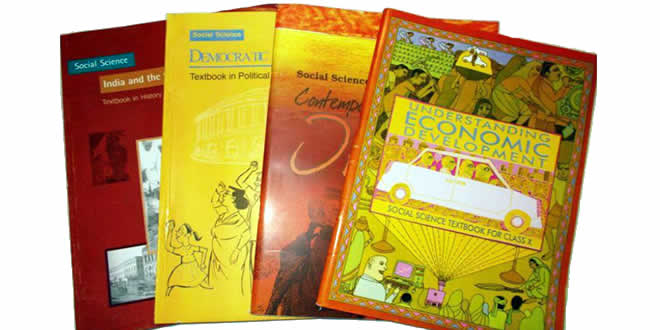10th Social Science Pre-board Test (2023-24): N. K. Bagrodia Public School, Ahinsa Marg, Sector 9, Rohini, New Delhi 110085
| School Name: | N. K. Bagrodia Public School, Sector 9, Rohini, New Delhi 110085 India |
| Class: | 10th Standard (CBSE) – Pre-board 2023-24 |
| Subject: | Social Science |
| Time Duration: | 03 Hours |
| Maximum Marks: | 80 |
| Date: | ~ December 2023 |
General Instructions: 10th Social Science Pre-board Test
- The question paper comprises six sections – A, B, C, D, E and F. There are 37 questions in the Question paper. All questions are compulsory.
- Section A – From questions 1 to 20 are MCQs of 1 mark each.
- Section B – Question no. 21 to 24 are Very Short Answer Type Questions, carrying 2 marks each. Answers to each question should not exceed 40 words.
- Section C contains Question no. 25 to 29 are Short Answer Type Questions, carrying 3 marks each. Answers to each question should not exceed 60 words.
- Section D – Question no. 30 to 33 are long answer type questions, carrying 5 marks each. Answers to each question should not exceed 120 words.
- Section E – Questions no from 34 to 36 are case based questions with three sub questions and are of 4 marks each.
- Section F – Question no. 37 is map based, carrying 5 marks with two parts, 37a from History (2 marks) and 37b from Geography (3 marks).
- There is no overall choice in the question paper. However, an internal choice has been provided in a few questions. Only one of the choices in such questions have to be attempted.
- In addition to this, separate instructions are given with each section and question, wherever necessary.
SECTION – A
MULTIPLE CHOICE TYPE QUESTIONS
Question 01: What were the objectives of the delegates to draw up the Treaty of Vienna of 1815?
- To make more changes in Europe after Napoleonic wars
- To distribute resources after the Napoleonic war
- To undo most of the changes that had come about in Europe during Napoleonic wars
- All the above
Question 02: What does the given image signify:
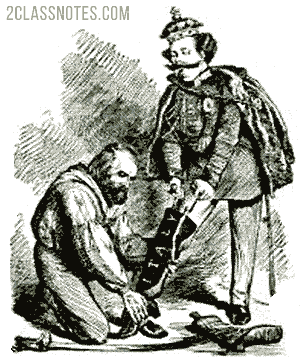
- Practice of slavery in Italy
- Subjugation of Italy
- Unification of Italy and Garibaldi’s role in it
- None of these
Question 03:
Assertion (A): Language played an important role in developing nationalist sentiments.
Reason (R): After Russian occupation, the Polish language was welcomed in schools and the Russian language Was forced out.
- Both A and R are true and R is the correct explanation of A.
- Both A and R are true but R is not the correct explanation of A.
- A is true but R is false.
- A is false but R is true.
Question 04:
Farmers and citizens groups in Tehri have shown that diversified crop product is possible without the use of synthetic chemicals and these methods are economically viable. the following conservation methods support the given statement?
- Chipko Movement
- Joint Forest Management
- Narmada Bachao Andolan
- Beej Bachao Andolan
Question 05:
‘X’ is a type of non conventional source of energy which is found in abundance in Himachal Pradesh and Ladakh regions of India. It refers to the heat and electricity produced by using the heat from the interior of the earth. Identify ‘X’ from the options given below:
- Nuclear Energy
- Geothermal Energy
- Tidal energy
- Hydro electricity
Question 06:
Which of the following is not a possible hazard of mining on the life of miners and on the environment?
a. Loss of livelihood of the people living in the vicinity of mines.
b. The dust and noxious fumes that cause pulmonary diseases.
c. Inundation and fires caused in coal mines.
d. Contamination of water sources in the mining regions.
Question 07:
Absenteeism is one of the most basic indicators of to what extent the educational needs of Students are met by schools. If the students are turning their back on the education they are provided, it means that we need to ask ourselves, “Is something happening in our schools and classrooms that distract students from education?” (Shute & Cooper, 2015)
Source: International Journal of Instruction (January 2016, Vol. 9, No.1)
The researchers are most likely referring to the factors that affect
- average income
- net attendance ratio
- literacy rate
- gross enrollment ratio
Question 08:
“Everything would come to an end if the legislative, executive and judicial powers of government were to be exercised by the same person or authority.”
– Montesquieu, French jurist
Which of the following is the best explanation of this quote?
- All work in a country will stop in the absence of power sharing.
- Separation of powers is needed to strengthen democracy.
- Government can only function if powers are distributed.
- People cannot exist in a nation if powers are not divided.
Question 09:
In the late 20th century, the island nation of Sri Lanka tore itself apart in a brutal civil war. The conflict between the Sri Lankan government and the Liberation Tigers of Tamil Eelam (LTTE) has lasted nearly three decades and is one of the longest-running civil wars in Asia. Identify the appropriate reason for the outbreak of this war in Sri Lanka.
- Policy of reservation
- Policy of absolutism
- Policy of isolation
- Policy of majoritarianism
Question 10:
Assertion (A): Power can be shared among governments at different levels- a general government for the entire country and governments at provincial or regional level.
Reason (R): Such a general government for the entire country is usually called the federal government.
- a. Both A and R are true and R is the correct explanation of A.
- b. Both A and R are true but R is not the correct explanation of A.
- C. A is true but R is false.
- d. A is false but R is true.
Question 11:
Following are the responses of four students of Ms. Menon to the distinguishing feature of a federal government:
Prerna– The National government gives some powers to the provincial government.
Harsimar– Power is distributed equally among the organs of government.
Kasim– Elected officials exercise supreme power in the government.
Navtej– Powers of the government are divided amongst different levels of government.
Whose response is correct and should be awarded according to the question asked?
- Prerna’s
- Harsimar’s
- Kasim’s
- Nevtej’s
Question 12:
Sumedha, a journalist in a local newspaper, believes that religion is ne Pe basis ot N community. Which of the following is the most suitable word for Sumedha:
- Feminist
- Casteist
- Secularist
- Communalist
Question 13:
“Print culture created the conditions within which the French Revolution occurred.” Which one of the following options does not support the given statement?
- Print popularised the ideas of the enlightened thinkers.
- Print provided a critical commentary on modernity and despotism.
- Print created a new culture of dialogues and debates.
- Print culture spread the views of nobility only.
Question 14:
The table given below shows the rate of economic growth for different countries from 1950 – 2000.
All democratic regimes
All dictatorial regimes
Poor countries under dictatorship
Poor countries under democracy
3.95
4.42
4.34
4.28
Which of the following statements stand true for the data given above:
- Dictatorships have a higher rate of economic growth than democracies.
- Poor countries exist only under democratic regimes.
- Dictatorship is the best solution for higher economic growth.
- There is a better growth rate of the poor countries under democratic regimes than that of dictatorships.
Question 15:
Varun believes in cultural nationalism as an important element in its conception of Indian nationhood and politics. Which of the following political parties has the similar ideology which he would like to join in the near future?
- Communist Party of India
- Bhartiya Janta Party
- Nationalist Congress Party
- All India Trinamool Congress
Question 16:
Which of the following options helps in promoting transparency in the governance?
- Right to education
- Right against exploitation
- Right to information
- Right to speech and expression
Question 17:
What will most likely be the aspiration of an educated urban unemployed youth?
- An educated urban unemployed youth will aspire for better opportunities in agriculture.
- Support from the government at every step in life for his upward movement.
- An urban educated unemployed will aspire for good job opportunities where his education can be made use of.
- Better facilities of recreation for his leisure time.
Question 18:
Read the given statements in context of ‘globalisation’ and choose the correct option:
- In the past two to three decades, more and more MNCs have been looking for locations around the world which would be cheap for their production
- MNGs are playing a major role in the globalisation process
- Besides the movements of goods, services, investments and technology, the movement of people between countries is also the result of globalisation
- All of these
Question 19:
Shafa works as a sales girl at a sweet shop in her village on a contract basis. She gets a meagre salary after working the entire day. She doesn’t get any holidays or paid leave, rather her employer deducts her salary whenever she is absent from work. Find out in which of the following sectors she is working?
- Primary Sector
- Secondary Sector
- Public Sector
- Unorganised Sector
Question 20:
Ram has to issue a cheque of 10,000 to Ramesh. He has to fill up all the blank spaces in the cheque. Choose the best option out of the following:
- Name of Ram on the cheque, date, amount in words and in digits, signature of Ramesh, account number of Ram and account payee.
- Name of Ram on the cheque, date, amount in words and in digits, account number of Ram and account payee.
- Name of Ramesh on the cheque, amount in words and in digits, signature of Ram, account payee
- Name of Ramesh on the cheque, date, amount in words and in digits, signature of Ram, account number of Ram and account payee.
SECTION – B
VERY SHORT ANSWER TYPE QUESTIONS
Question 21: Study the picture given below:
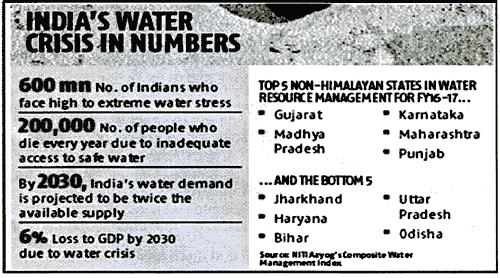
(Source: Business Standards)
List any two possible solutions to tackle this problem.
Question 22:
“The technology that was supposed to save us is ready to destroy us. New weapons are being made all the time, including chemical and biological weapons.”
In the light of the above statement, state how the global transfer of disease in the pre modern world helped in the colonisation of America.
Question 23:
“Secularism is not an ideology of some political parties or persons, but it is one of the foundations of our country.” Examine the statement.
Question 24:
“Lack of internal democracy within parties is the major challenge to political parties all over the world.” Analyse the statement.
SECTION – C
SHORT ANSWER TYPE QUESTIONS
Question 25: (3 marks)
“Daya has a very small piece of land on which she, her husband Kailash and two sons – Dala and Pita work together. Work is easily managed by the family members. Often, Dala and Pita do not come to the field. Their share of work is done by either Kailash or Daya. The family doesn’t get much income from the field and often takes loans from a local merchant to meet their basic needs that make their lives more miserable.”
The situation given above is one of many examples that continue to be rampant in Indian rural areas. Suggest any three ways through which the government can improve the economic conditions of these people.
Question 26: (3 marks)
What did the spread of print culture in the nineteenth century mean to women in India?
Question 27: (3 marks)
Discuss the most likely impacts if India operates without a system of resource planning. Build the answer around these points:
- Non renewable resources
- Regional development
- Ecological crisis
Question 28: (1+2 marks)
Australia became a nation on 1 January 1901, when the British Parliament passed legislation enabling the six Australian colonies to collectively govern in their own right as the Commonwealth of Australia. It was a remarkable political accomplishment that had taken many years and several referenda to achieve. (Source: Official website of the National Museum of Australia.)
What kind of federation is there in Australia? Briefly explain its features.
Question 29: (1+2 marks)
The following image shows sector wise contribution (%) of GDP in India for the years 2000 and 2013.
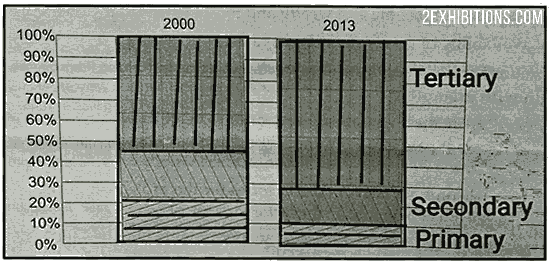
Which sector contributes the most in GDP for the year 2013? State any two reasons for the rising importance of the sector.
SECTION – D
LONG ANSWER TYPE QUESTION
Question 30: (5 marks)
While non-violence was always at the heart of Gandhi’s philosophy, he clearly regarded the planned salt march as a kind of military campaign. ‘We are entering upon a life and death struggle, a holy war,’ he said. Raising a handful of salty mud in his hand, he declared: ‘With this, I am shaking the foundations of the British Empire.’
Describe the main events leading to the Civil Disobedience Movement in light of their alignment with the philosophy of Satyagraha.
OR
“Dalit participation was limited in the Civil Disobedience Movement”. Examine the statement.
Question 31: 10th Social Science Pre-board Test (5 marks)
Democracy’s ability to generate its OWN support is itself an outcome that cannot be ignored Support the statement with examples.
OR
“On May 28, 2008, the newly elected Constituent assembly declared Nepal a Federal Democratic Republic, abolishing the 240 year-old monarchy. Nepal today has a President as Head of State and a Prime Minister heading the Government.”
The above statement shows that there is an overwhelming support for the idea of democracy in South Asia. Give reasons in support of the given statement.
Question 32: 10th Social Science Pre-board Test (5 marks)
Currently, our country has nearly 6.6 million SHGs on the list of successful SHGs in India and total of 70 million people working in these groups. The goal of the National Rural Livelihood Mission (NRLM) is to help 80 million households, and they want to reach this goal by 2025.
Analyse the given text describing the reasons for the growing popularity of Self help groups.
OR
“Deposits with banks are beneficial to the depositors as well as to the nation.” Examine the Statement.
Question 33: Read the following excerpt about food security and answer the question that follows: (5 marks)
Close to a billion people – one-eighth of the world’s population – still live in hunger. Each year 2 million children die through malnutrition. In July of 2022, the World Food Programme warned that, of the approximately 828 million people facing hunger, 345 million were experiencing acute hunger. Estimates suggest that there are 2.3 billion people facing less extreme but still dangerous, levels of food insecurity. That’s roughly 29% of the global population. Climate change poses a growing threat to food security, but one resilient solution emerging in the face of these challenges is the cultivation and consumption of millets. India is the largest producer and the second largest exporter of millets.
In the light of the given text, state the importance of millets and give a brief description of millets grown in India with the geographical conditions that these crops require.
OR
Mohan owns a farm in Uttar Pradesh; he wishes to cultivate either Jute or Sugarcane. Which crop out of these two he should cultivate keeping in mind the conditions required for their growth? Explain.
SECTION – E: 10th Social Science Pre-board Test
SOURCE BASED QUESTION
Question 34: Read the following lines from Sir Muhammad Iqbal’s addressal, reiterating the importance of a separate electorate for the Muslims and answer the questions that follow:
“I have no hesitation in declaring that if the principle that the Indian Muslim is entitled to full and free development on the lines of his own culture and tradition in his own Indian home-lands is recognised as the basis of a permanent communal settlement, he will be ready to stake his all or the freedom of India. The principle that each group is entitled to free development on its own mes is not inspired by any feeling of narrow communalism… A community which ts inspired by feelings of ill-will towards other communities is low and ignoble. I entertain the highest respect for the customs, laws, religions and social institutions of other communities. It is my duty according to the teachings of the Quran, even to defend their places of worship, if need be. Yet I love the communal group which is the source of life and behaviour and which has formed me what I am by giving me its religion, Its literature, its thought, ts culture and thereby its whole past as a living operative factor in my present consciousness. ‘Communalism in its higher aspect, |S indispensable 10 the formation of a harmonious whole in a country like India. The units of Indian society are not territorial as in European countries… The principle of European democracy cannot be applied to India without recognising the fact of communal groups. The Muslim India within India is, therefore, perfectly justified… The Hindu thinks that separate electorates are contrary to the spirit of true nationalism, because he understands the word “nation” to mean a kind of universal amalgamation in which no communal entity ought to retain its private individuality. Such a state of things, however, does not exist. India Is a land of racial and religious variety. Add to this the general economic inferiority of the Muslims, their enormous debt, especially in the Punjab, and their insufficient majorities in some of the provinces, as at present constituted and you will begin to see clearly the meaning of our anxiety to retain separate electorates.”
- What is the basic understanding of a nation by Hindus as per the given source? (1 mark)
- Mention any two statements that justify the demand for separate electorates by the Muslim League. (2 mark)
- What may be the result of narrow communalism? (1 mark)
Question 35: 10th Social Science Pre-board Test
The following table shows the proportion of adults (aged 15 – 49 years) whose BMI is below normal (BMI < 18.5 kg/m?) in India. It is based on a survey of various states for the year 2018-19. Look at the table and answer the questions that follow:
Sikkim
Karnataka
Madhya Pradesh
2.4
16.5
28.4
6.4
20.7
28.3
Source: National Family Health Survey, 2018-19
- Compare the nutritional level of people in Sikkim and Karnataka. (1 mark)
- Name the State where gender discrimination is least amongst the food insecure people. (1 mark)
- Around one-fifth of people in the country are malnourished even though it is argued that there is enough food in the country.” State any two possible reasons for the same. (2 mark)
Question 36: Study the information given below regarding manufacturing in the Aluminium Industry and answer the question that follows.
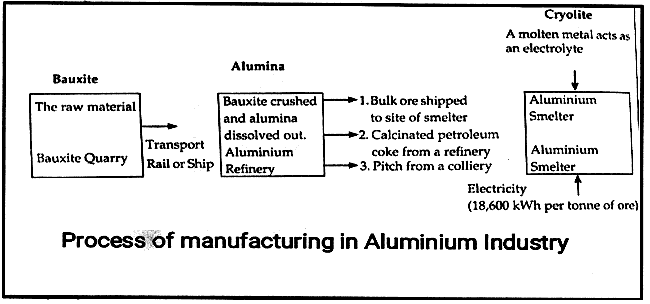
- What is the raw material used in the Aluminium industry? (1 mark)
- Other than an assured source of raw material and labour at minimum cost, state one prime factor for the location of the industry. (1 mark)
- “Aluminium smelting is the second most important metallurgical industry in India.” Justify. (2 marks)
SECTION – F: 10th Social Science Pre-board Test
MAP SKILL-BASED QUESTION
Question 37:
(a) Two places A and B have been marked on the given outline map of India. Identify them and write their correct names on the lines drawn near them. (2 marks)
- The place where cotton mill workers organised Satyagraha
- The 1927 Indian National Congress session was held at this place
OR
(b) On the same map of India, locate and label any three of the following with suitable symbols. (3 marks)
- A dam built on the river Ganga
- A software technology park in Northern India
- Southernmost port on the west coast of India
- A nuclear power plant in Uttar Pradesh
 Class Notes NCERT Solutions for CBSE Students
Class Notes NCERT Solutions for CBSE Students
